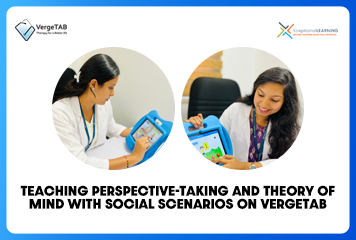Teaching Perspective-Taking and Theory of Mind with Social Scenarios on VergeTAB
07 Oct 2025

Imagine your child playing with a friend. They notice the friend frowning and looking away, pause the game, and ask, ŌĆ£Are you okay?ŌĆØ That simple question shows something powerful: your child has recognized a change in someone elseŌĆÖs emotions, guessed what they might be feeling, and responded with empathy. This is perspective-takingŌĆöthe ability to understand what others are thinking and feeling, and adjust behavior accordingly.
Also known as Theory of Mind (ToM), this skill typically develops through everyday social interactions. But children with developmental challengesŌĆösuch as autism, ADHD, or social learning difficultiesŌĆöoften need more structured support to build it.
Traditional methods often rely on memorized social scripts. While these offer a basic framework, they donŌĆÖt prepare children for the unpredictable nature of real-life interactions. True perspective-taking requires reasoning, predicting, interpreting emotions, sequencing events, and adapting to new situations. Digital therapy tools help by letting children explore social scenarios in a safe, structured, and interactive way.
VergeTAB, developed by XceptionalLEARNING (XL), is built for this. A dedicated therapy device, it works only with the XL platform and delivers social-emotional learning through guided digital experiences. With engaging visuals, therapist-curated activities, and real-time feedback, VergeTAB helps children develop perspective-taking skills they can apply in everyday life.
Core Skills Developed Through VergeTAB
VergeTAB focuses on practical skill-building. Every activity is designed to target a cognitive function that serves as a building block for perspective-taking. Through guided exercises, children practice the following core competencies:
- Empathy and Emotional Recognition
- Recognizing emotions through facial expressions, gestures, and tone.
- Connecting actions with emotional consequences.
- Predictive Thinking
- Anticipating othersŌĆÖ reactions in social situations.
- Considering multiple possible responses and outcomes.
- Sequencing and Cause-Effect Reasoning
- Understanding the order of events in social interactions.
- Linking actions to emotional or social outcomes.
- Abstract and Symbolic Thinking
- Interpreting gestures, body language, and subtle social gestures.
- Understanding that symbols or expressions can represent thoughts and feelings.
- Decision-Making and Problem-Solving
- Choosing socially appropriate responses.
- Adapting actions based on context.
- Communication Skills
- Expressing understanding of othersŌĆÖ perspectives verbally.
- Building vocabulary for thoughts, emotions, and intentions.
These competencies form the foundation of Theory of Mind and prepare children for meaningful, confident participation in social life.
Using Social Scenarios to Teach Perspective-Taking
VergeTABŌĆÖs greatest strength lies in its use of social scenariosŌĆödigital stories and exercises where children interact with characters, predict outcomes, and practice reasoning. Below are structured activity types, each designed to build a different cognitive skill required for perspective-taking.
1. Observing and Interpreting Social Cues
Objective:
Help children identify and understand othersŌĆÖ thoughts and emotions from verbal and non-verbal signs, such as tone, gestures, and facial expressions.
Sample Activity:
- Animated story: ŌĆ£Riya accidentally bumps into Maya at school.ŌĆØ
- Prompts:
- ŌĆ£How does Maya feel?ŌĆØ
- ŌĆ£What could Riya do to make her feel better?ŌĆØ
- Children can select options, drag-and-drop responses, or type their answers.
Practical Tip: After the digital activity, role-play similar situations in real life. For example: ŌĆ£What happens if someone accidentally knocks over your blocks?ŌĆØ Encourage children to observe classmatesŌĆÖ reactions and describe what they notice.
Skills Developed: Children learn to recognize othersŌĆÖ emotions, understand their perspective, and reason about social situations.
Therapies and Interventions:
- Occupational Therapy (OT): Builds social participation and self-regulation.
- Speech and Language Therapy (SLT): Practices labelling emotions and expressing thoughts.
- Social Skills Groups: Reinforces interpreting othersŌĆÖ reactions in social settings.
2. Predicting Thoughts and Feelings
Objective:
Teach children to anticipate othersŌĆÖ reactions and consider multiple possibilities before responding.
Sample Activity:
- Scenario: ŌĆ£Anna refuses to share her colouring pencils.ŌĆØ
- Prompts:
- ŌĆ£Why might Anna not want to share?ŌĆØ
- ŌĆ£What are three ways to solve the problem?ŌĆØ
- Children select or sequence logical or empathetic solutions.
Practical Tip: Encourage children to verbalize their reasoning: ŌĆ£I think Anna didnŌĆÖt share because she wanted to finish first, so she might feel proud when she completes the picture.ŌĆØ Reinforce predictions in daily life, e.g., ŌĆ£How might your friend feel if you donŌĆÖt take turns?ŌĆØ
Skills Developed: Children practice anticipating reactions, making empathetic decisions, and solving social problems.
Therapies and Interventions:
- Cognitive Behavioural Therapy (CBT): Strengthens awareness of cause-and-effect and builds balancing strategies.
- Applied Behaviour Analysis (ABA): Promotes predicting and responding appropriately through structured practice.
- Social and Emotional Learning (SEL): Builds group-based empathy and perspective awareness.
3. Sequencing and Understanding Cause-Effect
Objective:
Help children understand the order of social events and link actions to their consequences.
Sample Activity:
- Story: ŌĆ£A character spills juice, apologizes, and cleans up.ŌĆØ
- Tasks:
- Drag-and-drop steps in the correct order.
- Match each step to the characterŌĆÖs emotion.
- Discuss how earlier actions influence later outcomes.
Practical Tip: Use daily routines (like brushing teeth or packing school bags) to practice sequencing. Strengthens learning with visual schedules or storyboards.
Skills Developed: Children strengthen logical organization, cause-and-effect reasoning, and social planning.
Therapies and Interventions:
- Occupational Therapy (OT): Improves executive functioning and sequencing.
- Cognitive Therapy: Enhances logical reasoning.
- Speech Therapy: Builds verbal explanation of cause and effect.
4. Abstract and Symbolic Reasoning
Objective:
Enable children to recognize subtle social cues and understand that gestures, expressions, or symbols represent internal states.
Sample Activity:
- Scenario: ŌĆ£A character crosses arms and frowns when asked to share a toy.ŌĆØ
- Tasks:
- Identify the characterŌĆÖs feeling: annoyed or frustrated.
- Infer the likely thought: ŌĆ£I donŌĆÖt want to give this away yet.ŌĆØ
- Suggest possible resolutions: offering a trade, asking for a turn, or expressing feelings.
Practical Tip: Practice interpreting body language in daily life. Use emoji cards, gesture games, or drawing activities to reinforce abstract reasoning.
Skills Developed: Children learn to interpret subtle cues, connect symbols to feelings, and understand hidden intentions.
Therapies and Interventions:
- Social Skills Training (SST): Builds awareness of peer cues.
- CBT: Connects internal states with observable behaviour.
- SLT: Develops vocabulary for describing abstract emotions.
- Play Therapy: Encourages symbolic exploration in safe play contexts.
Enhancing Engagement on VergeTAB
VergeTAB is designed to ensure children not only complete activities, but also remain engaged and motivated throughout therapy.
- Sensory-Friendly Design
- Gentle animations and audio hints prevent sensory overload.
- Calm interface ensures focus and sustained learning.
- Adaptive Difficulty and Personalization
- Activities adjust to each childŌĆÖs skill level.
- Encourage safe exploration of multiple responses without frustration.
- Visual and Audio Reinforcement
- Animated sequences and sound cues strengthen understanding of social outcomes.
- Supports vocabulary building and abstract concept comprehension.
- Progress Tracking and Data Insights
- Real-time reports for parents and therapists.
- Activity-specific feedback allows targeted goal adjustment.
This ensures therapy remains structured, measurable, and personalized.
Additional Notes for Parents, Therapists, and Educators
- Pair digital with real-life practice: Skills become meaningful when practiced both on VergeTAB and in everyday life.
- Encourage reflection: Ask children to explain why they chose an answer. This builds reasoning and verbal communication.
- Leverage progress reports: Use XLŌĆÖs data insights to identify gaps in sequencing, predicting, or abstract reasoning.
- Integrate therapies: A multi-disciplinary approach, including Occupational Therapy (OT), Speech and Language Therapy (SLT), Cognitive Behavioural Therapy (CBT), Applied Behaviour Analysis (ABA), and Social and Emotional Learning (SEL), ensures skills are reinforced across contexts.
Conclusion
Teaching Perspective-Taking and Theory of Mind is not just about showing children what to doŌĆöitŌĆÖs about nurturing their ability to think, reason, and empathize. With VergeTAB, this process becomes:
- Structured through realistic social scenarios
- Engaging via interactive digital activities
- Measurable with progress tracking and feedback
- Transferable to real-world social situations
By practicing multiple skills, children build the cognitive foundation to understand others, communicate effectively, and make socially appropriate decisions. Children can thus gain emotional insight, social confidence, and independenceŌĆötransforming digital practice into meaningful, real-life social success.
For parents, therapists, and educators, VergeTAB is more than just a tool; itŌĆÖs a Digital Therapy Activity Device designed for todayŌĆÖs learning needs. Recognized as the best tablet for therapy, it supports children with developmental challenges while empowering professionals to deliver the best therapy services with tab–based solutions. To learn more or connect with our team, contact us today.┬Ā


